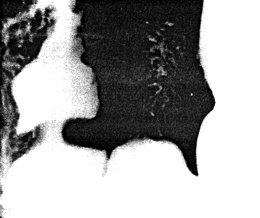



Go to chapter: 1 | 2 | 3 | 4 | 5 | 6 | 7 | 8 | 9 | 10 | 11 | 12 | 13 | 14 | 15 | 16 | 17 | 18 | 19 | 20 | 21 | 22 | 23 | 24 | 25 | 26 | 27 | 28 | 29 | 30 | 31 | 32 | 33 | 34 | 35 | 36 | 37 | 38 | 39
Chapter 13 (page 65)
Radiologically the following types of closure of the aperture may be recognized:
- Dynamic closure due to muscular contraction of the sphincteric
cylinder
From the above it is concluded that, when the sphincteric cylinder is relaxed or
expanded, the aperture is patent. Maximal contraction of the cylinder, with
formation of the pyloric canal, closes the aperture.
During contraction of the cylinder there may be an interplay between its right
pyloric loop (surrounding the aperture) and its left loop. Should the former close
first, retropulsion of contents may occur. Should the left loop close first,
propulsion may occur.
Permanent, partial contraction of the sphincteric cylinder (which is regarded as a
type of pylorospasm, as described in Chapter 20), may "fix" the aperture in a
patent position, midway between maximal patency and maximal closure.
- Closure due to converging mucosal folds.
When the pyloric sphincteric cylinder is relaxed, its mucosal folds are circular.
The folds may converge on the aperture or close it in an iris-like way.
- Descent or sagging of filled stomach.
The pyloric aperture in the filled stomach may be patent (Fig. 13.20). A sudden
descent or sagging of the stomach may cause apparent elongation of the aperture
with passive narrowing of its diameter (Fig. 13.21).
Gastric hypotonicity with delayed emptying in the erect position, is often ascribed to
pylorospasm, by which is meant spasm of the pyloric ring with closure of the aperture.
However, there is reason to believe that the aperture is patent in these cases (Chap. 19).
 |
Fig. 13.20.
The stomach is filled, the sphincteric cylinder expanded, and the aperture patent
|
 |
Fig. 13.21.
Sagging of stomach causes elongation and apparent narrowing of the aperture
|
Previous Page | Table of Contents | Next Page
© Copyright PLiG 1998








